A Collaborative Multiplicative Holt-Winters Forecasting Approach with Dynamic Fuzzy-Level Component
Abstract
:1. Introduction
2. Literature Review
3. Proposed Methodology
4. Development Stages of the Proposed Approach
4.1. Development Stages of the Proposed Approach
4.2. Development Process of Smoothing Constant Simulator
| 1. Input: dataset 2. Initialize parameters 3. FOR α = 0 to 1 step 0.1 4. FOR β = 0 to 1 step 0.1 5. FOR γ = 0 to 1 step 0.1 6. Calculate first step ahead forecast: 7. Multiplicative Holt-Winters 8. Calculate mean absolute deviation: MAD 9. END FOR 10. END FOR 11. END FOR 12. Find optimum α, β and γ correspond to minimum value of MAD 13. OUTPUT: Optimum α, β and γ. |
4.3. Development Process of Smoothing Constant Simulator
4.4. Estimation of the Parameter Level (LTpred) and the Forecast
4.5. Accuracy Assessment
5. Application of Our Proposed Approach
5.1. Case Study-1: Demand Data for Transformer Tanks
5.1.1. Determination of the Smoothing Constants
5.1.2. Determination of the Initial Values
5.1.3. Development of Level Prediction Model
Choice of Inference Mechanism and Variables
Fuzzification and Formulation of Membership Functions
Development of Fuzzy Inference Rules and Process
5.1.4. Prediction of Level and Consequent Forecast
5.2. Case Study-2: Average Sales Data of Danfoss District Heating
5.3. Case Study-3: Demand Data for Plastic Bags
6. Results and Discussions
6.1. Evaluation of the Forecasting Accuracy
6.2. Assessing the Coefficient of Determination
7. Conclusions
Acknowledgments
Author Contributions
Conflicts of Interest
Appendix A



References
- Mao, J. Customer Brand Loyalty. Int. J. Bus. Manag. 2010, 5, 213–217. [Google Scholar] [CrossRef]
- Yelland, P.M. Bayesian forecasting of parts demand. Int. J. Forecast. 2010, 26, 374–396. [Google Scholar] [CrossRef]
- Marmier, F.; Cheikhrouhou, N. Structuring and integrating human knowledge in demand forecasting: A judgemental adjustment approach. Prod. Plan. Control 2010, 21, 399–412. [Google Scholar] [CrossRef]
- Co, H.C.; Boosarawongse, R. Forecasting Thailand’s rice export: Statistical techniques vs. artificial neural networks. Comput. Ind. Eng. 2007, 53, 610–627. [Google Scholar] [CrossRef]
- Winters, P.R. Forecasting sales by exponentially weighted moving averages. Manag. Sci. 1960, 6, 324–342. [Google Scholar] [CrossRef]
- Gardner, M.P. Mood states and consumer behavior: A critical review. J. Consum. Res. 1985, 12, 281–300. [Google Scholar] [CrossRef]
- Gardner, E.S. Evaluating forecast performance in an inventory control system. Manag. Sci. 1990, 36, 490–499. [Google Scholar] [CrossRef]
- Taylor, J.W. Short-term electricity demand forecasting using double seasonal exponential smoothing. J. Oper. Res. Soc. 2003, 54, 799–805. [Google Scholar] [CrossRef]
- Billah, B.; King, M.L.; Snyder, R.D.; Koehler, A.B. Exponential smoothing model selection for forecasting. Int. J. Forecast. 2006, 22, 239–247. [Google Scholar] [CrossRef]
- Brown, R.G. Statistical Forecasting for Inventory Control; McGraw/Hill: New York, NY, USA, 1959. [Google Scholar]
- Holt, C.C. Forecasting seasonals and trends by exponentially weighted moving averages. Int. J. Forecast. 2004, 20, 5–13. [Google Scholar] [CrossRef]
- Hyndman, R.J.; Koehler, A.B.; Snyder, R.D.; Grose, S. A state space framework for automatic forecasting using exponential smoothing methods. Int. J. Forecast. 2002, 18, 439–454. [Google Scholar] [CrossRef]
- Lawton, R. How should additive Holt-Winters estimates be corrected? Int. J. Forecast. 1998, 14, 393–403. [Google Scholar] [CrossRef]
- Segura, J.V.; Vercher, E. A spreadsheet modeling approach to the Holt-Winters optimal forecasting. Eur. J. Oper. Res. 2001, 131, 375–388. [Google Scholar] [CrossRef]
- Bruce, L.; Richard, T.; Anne, B. Forecasting Time Series and Regression; Thomson Brooks/Cole: Stamford, CT, USA, 2005. [Google Scholar]
- Koehler, A.B.; Snyder, R.D.; Ord, J.K. Forecasting models and prediction intervals for the multiplicative Holt-Winters method. Int. J. Forecast. 2001, 17, 269–286. [Google Scholar] [CrossRef]
- Chatfield, C.; Yar, M. Prediction intervals for multiplicative Holt-Winters. Int. J. Forecast. 1991, 7, 31–37. [Google Scholar] [CrossRef]
- Kays, H.E.; Karim, A.N.M.; Hasan, M.; Sarker, R.A. Impact of initial level and growth rate in multiplicative HW model on bullwhip effect in a supply chain. In Data and Decision Sciences in Action; Springer: Cham, Switzerland, 2018; pp. 357–368. [Google Scholar]
- Hassani, H.; Abdollahzadeh, M.; Iranmanesh, H.; Miranian, A. A self-similar local neuro-fuzzy model for short-term demand forecasting. J. Syst. Sci. Complex. 2014, 27, 3–20. [Google Scholar] [CrossRef]
- Arrais-Castro, A.; Varela, M.L.R.; Putnik, G.D.; Ribeiro, R.; Dargam, F.C. Collaborative negotiation platform using a dynamic multi-criteria decision model. Int. J. Decis. Support Syst. Technol. 2015, 7, 1–14. [Google Scholar] [CrossRef]
- Lozano, Á.; De Paz, J.F.; Villarrubia González, G.; Iglesia, D.H.; Bajo, J. Multi-Agent System for Demand Prediction and Trip Visualization in Bike Sharing Systems. Appl. Sci. 2018, 8, 67. [Google Scholar] [CrossRef]
- Alfian, G.; Rhee, J.; Ijaz, M.F.; Syafrudin, M.; Fitriyani, N.L. Performance Analysis of a Forecasting Relocation Model for One-Way Carsharing. Appl. Sci. 2017, 7, 598. [Google Scholar] [CrossRef]
- Lu, J.; Bai, D.; Zhang, N.; Yu, T.; Zhang, X. Fuzzy Case-Based Reasoning System. Appl. Sci. 2016, 6, 189. [Google Scholar] [CrossRef]
- Bermúdez, J.D.; Segura, J.V.; Vercher, E. A decision support system methodology for forecasting of time series based on soft computing. Comput. Stat. Data Anal. 2006, 51, 177–191. [Google Scholar] [CrossRef]
- Dong, R.; Pedrycz, W. A granular time series approach to long-term forecasting and trend forecasting. Phys. A Stat. Mech. Appl. 2008, 387, 3253–3270. [Google Scholar] [CrossRef]
- Hamzaçebi, C.; Akay, D.; Kutay, F. Comparison of direct and iterative artificial neural network forecast approaches in multi-periodic time series forecasting. Expert Syst. Appl. 2009, 36, 3839–3844. [Google Scholar] [CrossRef]
- Bowerman, B.L.; O’Connell, R.T.; Koehler, A.B. Forecasting, Time Series, and Regression: An Applied Approach; South-Western Pub: Nashville, TN, USA, 2005; Volume 4. [Google Scholar]
- Gardner, E.S., Jr. Exponential smoothing: The state of the art—Part II. Int. J. Forecast. 2006, 22, 637–666. [Google Scholar] [CrossRef]
- Snyder, R.D.; Koehler, A.B.; Hyndman, R.J.; Ord, J.K. Exponential smoothing models: Means and variances for lead-time demand. Eur. J. Oper. Res. 2004, 158, 444–455. [Google Scholar] [CrossRef]
- Taylor, J.W. Exponential smoothing with a damped multiplicative trend. Int. J. Forecast. 2003, 19, 715–725. [Google Scholar] [CrossRef]
- Bermúdez, J.D.; Segura, J.V.; Vercher, E. Holt-Winters forecasting: An alternative formulation applied to UK air passenger data. J. Appl. Stat. 2007, 34, 1075–1090. [Google Scholar] [CrossRef]
- Maia, A.L.S.; de Carvalho, F.D.A. Holt’s exponential smoothing and neural network models for forecasting interval-valued time series. Int. J. Forecast. 2011, 27, 740–759. [Google Scholar] [CrossRef]
- Vroman, P.; Happiette, M.; Rabenasolo, B. Fuzzy Adaptation of the Holt–Winter Model for Textile Sales-forecasting. J. Text. Inst. 1998, 89, 78–89. [Google Scholar] [CrossRef]
- Grubb, H.; Mason, A. Long lead-time forecasting of UK air passengers by Holt-Winters methods with damped trend. Int. J. Forecast. 2001, 17, 71–82. [Google Scholar] [CrossRef]
- Lepojević, V.; Anđelković-Pešić, M. Forecasting Electricity Consumption by Using Holt-Winters and Seasonal Regression Models. Econ. Org. 2016, 8, 421–431. [Google Scholar]
- Tratar, L.F. Joint optimisation of demand forecasting and stock control parameters. Int. J. Prod. Econ. 2010, 127, 173–179. [Google Scholar] [CrossRef]
- Taylor, J.W. Triple seasonal methods for short-term electricity demand forecasting. Eur. J. Oper. Res. 2010, 204, 139–152. [Google Scholar] [CrossRef]
- Arora, S.; Taylor, J.W. Short-term forecasting of anomalous load using rule-based triple seasonal methods. IEEE Trans. Power Syst. 2013, 28, 3235–3242. [Google Scholar] [CrossRef]
- Sudheer, G.; Suseelatha, A. Short term load forecasting using wavelet transform combined with Holt-Winters and weighted nearest neighbor models. Int. J. Electr. Power Energy Syst. 2015, 64, 340–346. [Google Scholar] [CrossRef]
- Costantino, F.; Di Gravio, G.; Shaban, A.; Tronci, M. Smoothing inventory decision rules in seasonal supply chains. Expert Syst. Appl. 2016, 44, 304–319. [Google Scholar] [CrossRef]
- Cheikhrouhou, N.; Marmier, F.; Ayadi, O.; Wieser, P. A collaborative demand forecasting process with event-based fuzzy judgements. Comput. Ind. Eng. 2011, 61, 409–421. [Google Scholar] [CrossRef]
- Abdesselam, M.; Karim, A.N.; Emrul Kays, H.M.; Sarker, R.A. Forecasting demand: Development of a fuzzy growth adjusted Holt-Winters approach. In Advanced Materials Research; Trans Tech Publications: Zürich, Switzerland, 2014; Volume 903, pp. 402–407. [Google Scholar]
- Yagiz, S.; Gokceoglu, C. Application of fuzzy inference system and nonlinear regression models for predicting rock brittleness. Expert Syst. Appl. 2010, 37, 2265–2272. [Google Scholar] [CrossRef]
- Syn, C.Z.; Mokhtar, M.; Feng, C.J.; Manurung, Y.H. Approach to prediction of laser cutting quality by employing fuzzy expert system. Expert Syst. Appl. 2011, 38, 7558–7568. [Google Scholar] [CrossRef]
- Asklany, S.A.; Elhelow, K.; Youssef, I.K.; El-Wahab, M.A. Rainfall events prediction using rule-based fuzzy inference system. Atmos. Res. 2011, 101, 228–236. [Google Scholar] [CrossRef]
- Akpınar, A.; Özger, M.; Kömürcü, M.İ. Prediction of wave parameters by using fuzzy inference system and the parametric models along the south coasts of the Black Sea. J. Mar. Sci. Technol. 2014, 19, 1–14. [Google Scholar] [CrossRef]
- Shams, S.; Monjezi, M.; Majd, V.J.; Armaghani, D.J. Application of fuzzy inference system for prediction of rock fragmentation induced by blasting. Arab. J. Geosci. 2015, 8, 10819–10832. [Google Scholar] [CrossRef]
- Wag, M.; Qiu, J.; Chadli, M.; Wang, M. A switched system approach to exponential stabilization of sampled-data T–S fuzzy systems with packet dropouts. IEEE Trans. Cybern. 2016, 46, 3145–3156. [Google Scholar] [CrossRef] [PubMed]
- Hu, C.; Jing, H.; Wang, R.; Yan, F.; Chadli, M. Robust H∞ output-feedback control for path following of autonomous ground vehicles. Mech. Syst. Signal Process. 2016, 70, 414–427. [Google Scholar] [CrossRef]
- Yang, T.; Qiu, W.; Ma, Y.; Chadli, M.; Zhang, L. Fuzzy model-based predictive control of dissolved oxygen in activated sludge processes. Neurocomputing 2014, 136, 88–95. [Google Scholar] [CrossRef]
- Youssef, T.; Chadli, M.; Karimi, H.R.; Wang, R. Actuator and sensor faults estimation based on proportional integral observer for TS fuzzy model. J. Franklin Inst. 2017, 354, 2524–2542. [Google Scholar] [CrossRef]
- Chibani, A.; Chadli, M.; Shi, P.; Braiek, N.B. Fuzzy fault detection filter design for t–s fuzzy systems in the finite-frequency domain. IEEE Trans. Fuzzy Syst. 2017, 25, 1051–1061. [Google Scholar] [CrossRef]
- Mamlook, R.; Badran, O.; Abdulhadi, E. A fuzzy inference model for short-term load forecasting. Energy Policy 2009, 37, 1239–1248. [Google Scholar] [CrossRef]
- Huang, C.-M.; Huang, Y.-C.; Huang, C.-J. An Intelligence-Based Fuzzy Inference System for Smart Home Real-Time Load Forecasting. Procedia Eng. 2012, 50, 297–304. [Google Scholar]
- Özger, M. Comparison of fuzzy inference systems for streamflow prediction. Hydrol. Sci. J. 2009, 54, 261–273. [Google Scholar] [CrossRef]
- Darain, K.M.; Shamshirband, S.; Jumaat, M.Z.; Obaydullah, M. Adaptive neuro fuzzy prediction of deflection and cracking behavior of NSM strengthened RC beams. Constr. Build. Mater. 2015, 98, 276–285. [Google Scholar] [CrossRef]
- Hossain, A.; Hossain, A.; Nukman, Y.; Hassan, M.A.; Harizam, M.Z.; Sifullah, A.M.; Parandoush, P. A fuzzy logic-based prediction model for kerf width in laser beam machining. Mater. Manuf. Process. 2016, 31, 679–684. [Google Scholar] [CrossRef]
- Xu, J.; Tu, Y.; Zeng, Z. Bilevel optimization of regional water resources allocation problem under fuzzy random environment. J. Water Resour. Plan. Manag. 2012, 139, 246–264. [Google Scholar] [CrossRef]
- Chen, S.-M.; Tanuwijaya, K. Fuzzy forecasting based on high-order fuzzy logical relationships and automatic clustering techniques. Expert Syst. Appl. 2011, 38, 15425–15437. [Google Scholar] [CrossRef]
- Wu, L.; Seo, D.J.; Demargne, J.; Brown, J.D.; Cong, S.; Schaake, J. Generation of ensemble precipitation forecast from single-valued quantitative precipitation forecast for hydrologic ensemble prediction. J. Hydrol. 2011, 399, 281–298. [Google Scholar] [CrossRef]
- Chen, S.M.; Tanuwijaya, K. Multivariate fuzzy forecasting based on fuzzy time series and automatic clustering techniques. Expert Syst. Appl. 2011, 38, 10594–10605. [Google Scholar] [CrossRef]
- Hossain, F.; Siddique-E-Akbor, A.H.; Mazumder, L.C.; ShahNewaz, S.M.; Biancamaria, S.; Lee, H.; Shum, C.K. Proof of concept of an altimeter-based river forecasting system for transboundary flow inside Bangladesh. IEEE J. Sel. Top. Appl. Earth Obs. Remote Sens. 2014, 7, 587–601. [Google Scholar] [CrossRef] [Green Version]
- Pombo, S.; de Oliveira, R.P.; Mendes, A. Validation of remote-sensing precipitation products for Angola. Meteorol. Appl. 2015, 22, 395–409. [Google Scholar] [CrossRef]
- Li, H.; Yen, V.C. Fuzzy Sets and Fuzzy Decision-Making; CRC Press: Boca Raton, FL, USA, 1995. [Google Scholar]
- Abele, E.; Anderl, R.; Birkhofer, H. Environmentally-Friendly Product Development; Springer: London, UK, 2005. [Google Scholar]
- Cornelissen, A.M.G.; van den Berg, J.; Koops, W.J.; Grossman, M.; Udo, H.M.J. Assessment of the contribution of sustainability indicators to sustainable development: A novel approach using fuzzy set theory. Agric. Ecosyst. Environ. 2001, 86, 173–185. [Google Scholar] [CrossRef]
- Chu, T.C.; Tsao, C.T. Ranking fuzzy numbers with an area between the centroid point and original point. Comput. Math. Appl. 2002, 43, 111–117. [Google Scholar] [CrossRef]
- Rahman, Q.I.; Malik, A.N. Adaptive resource allocation in OFDM systems using GA and fuzzy rule base system. World Appl. Sci. J. 2012, 18, 836–844. [Google Scholar]
- Hossain, A.; Rahman, A.; Hossen, J.; Iqbal, A.K.M.P.; Zahirul, M.I. Prediction of aerodynamic characteristics of an aircraft model with and without winglet using fuzzy logic technique. Aerosp. Sci. Technol. 2011, 15, 595–605. [Google Scholar] [CrossRef]
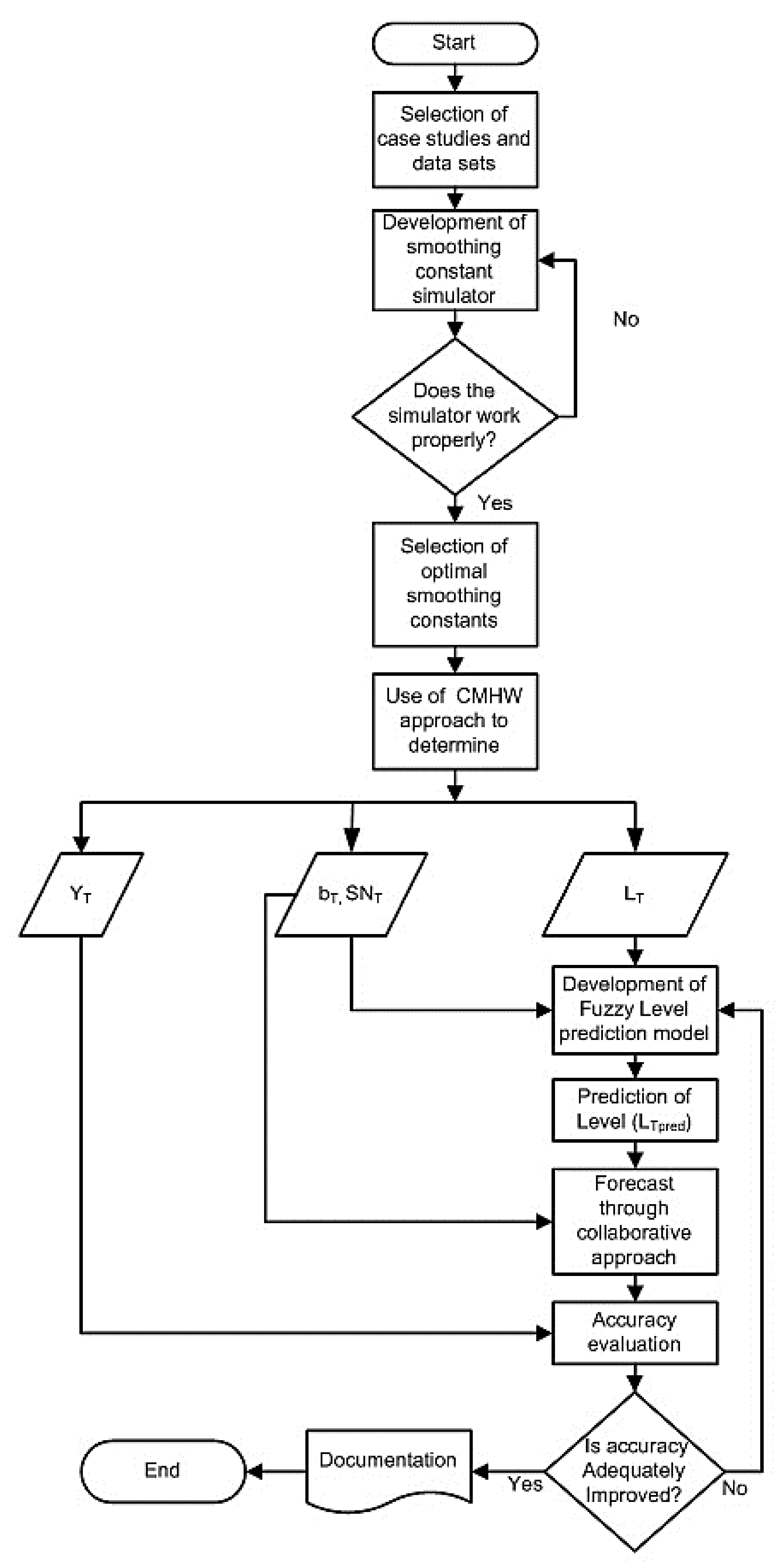
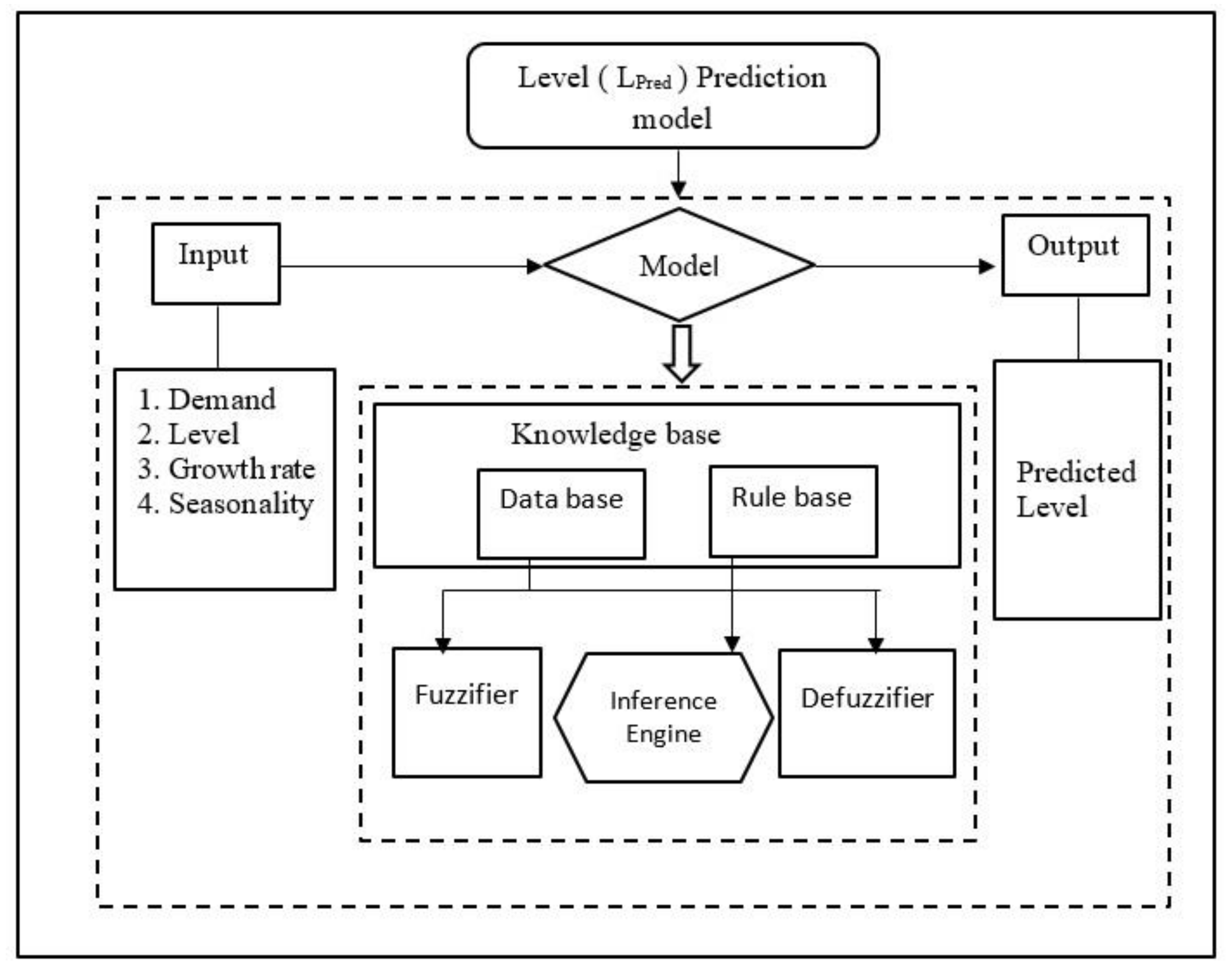
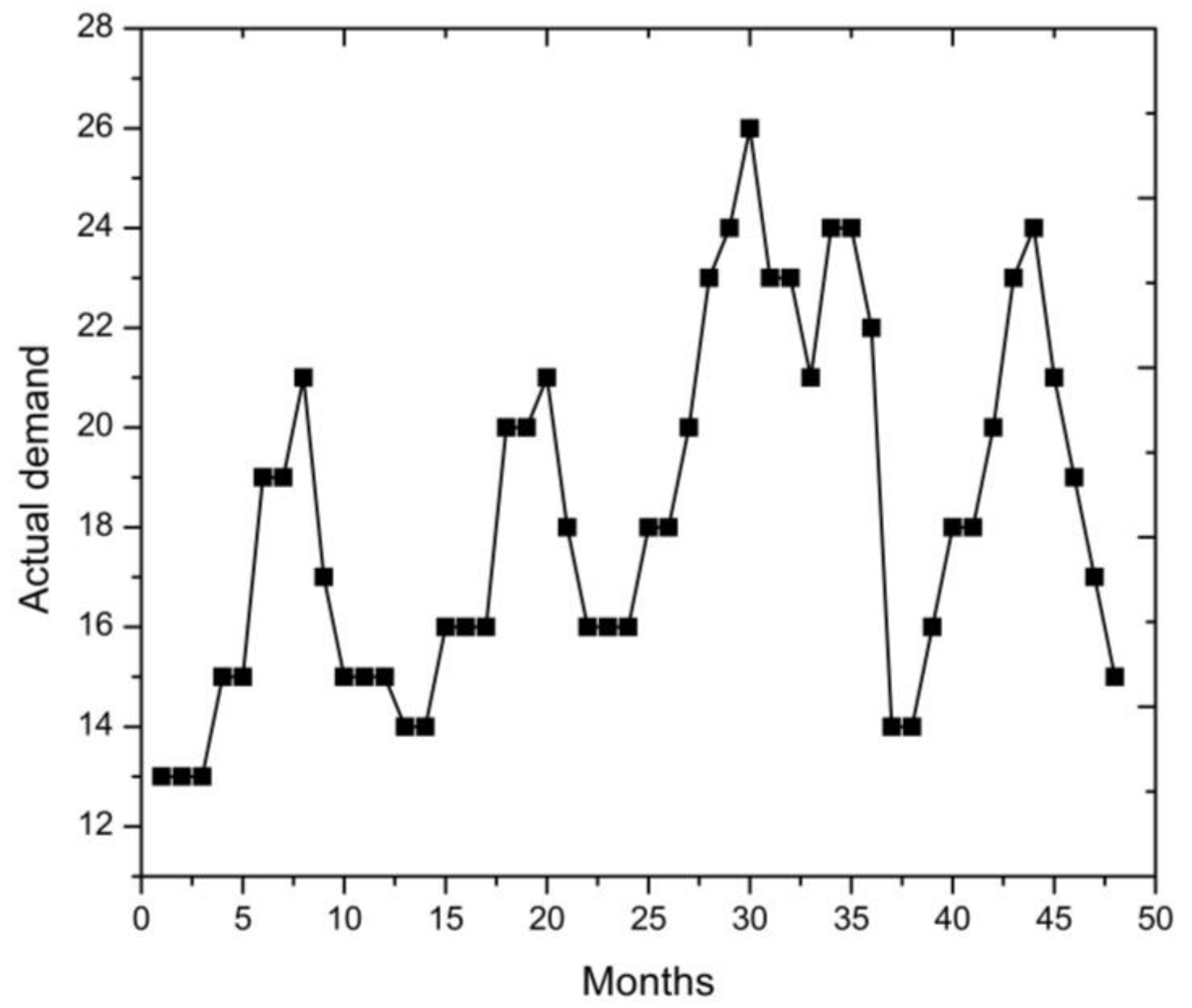
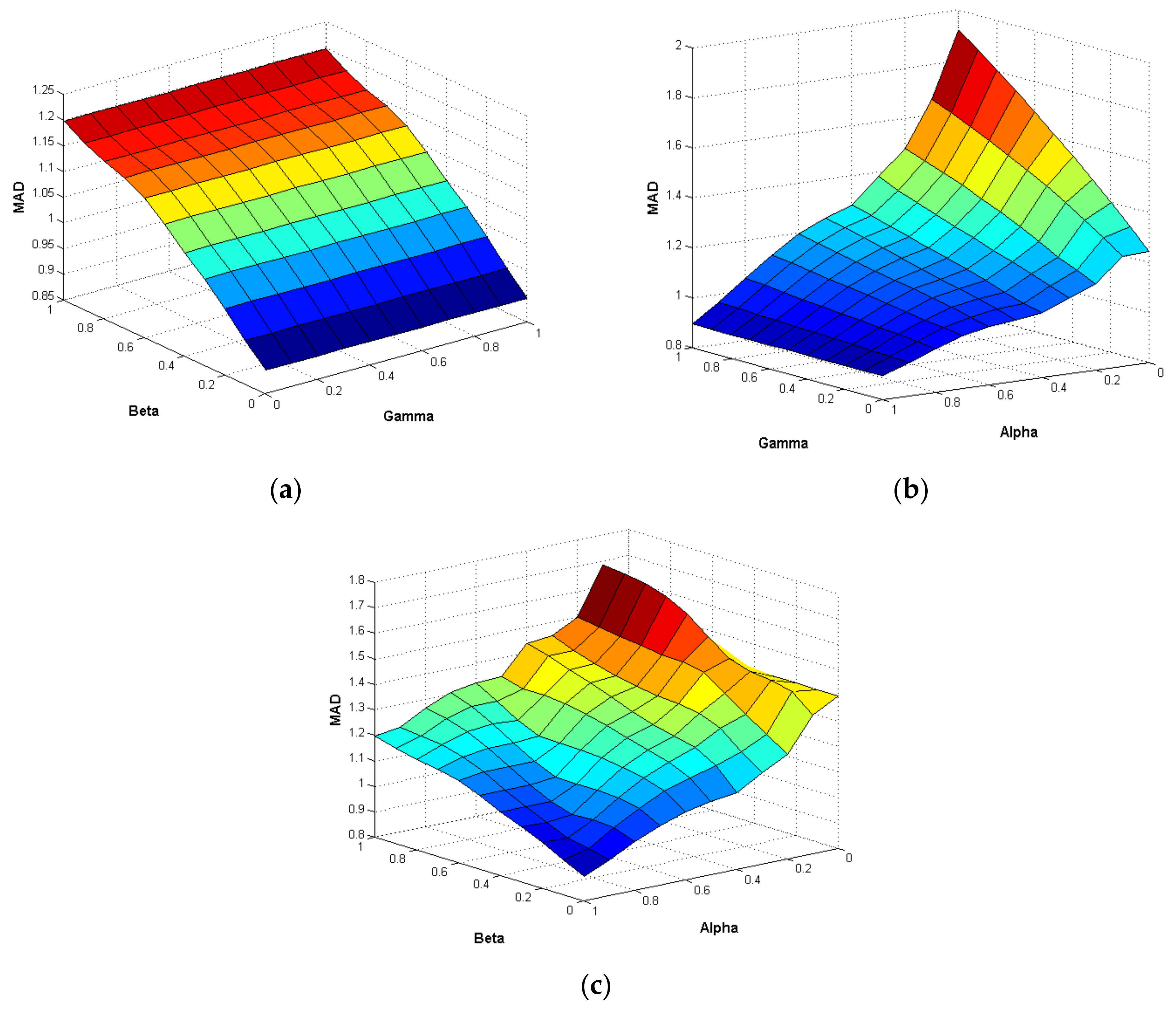
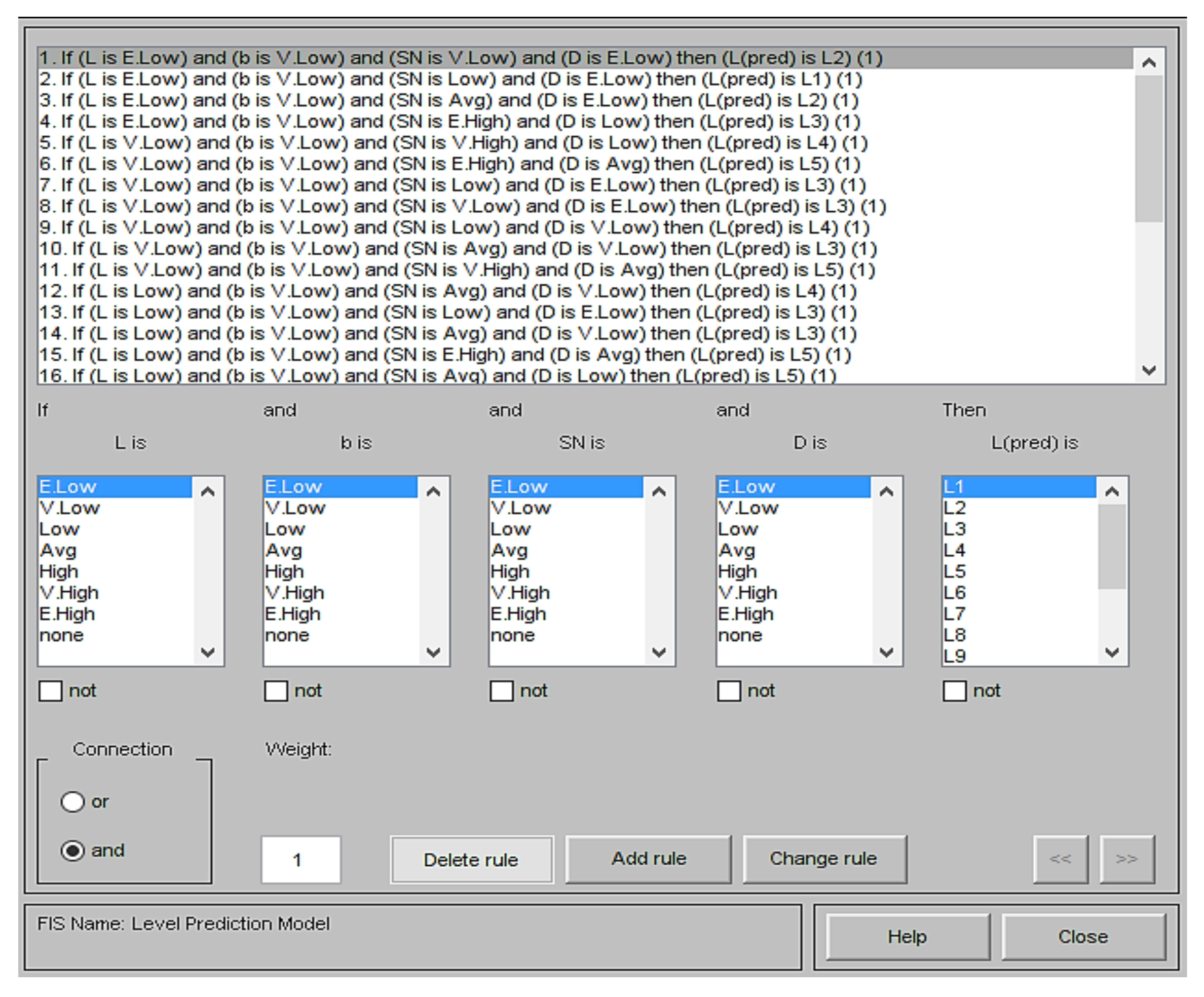




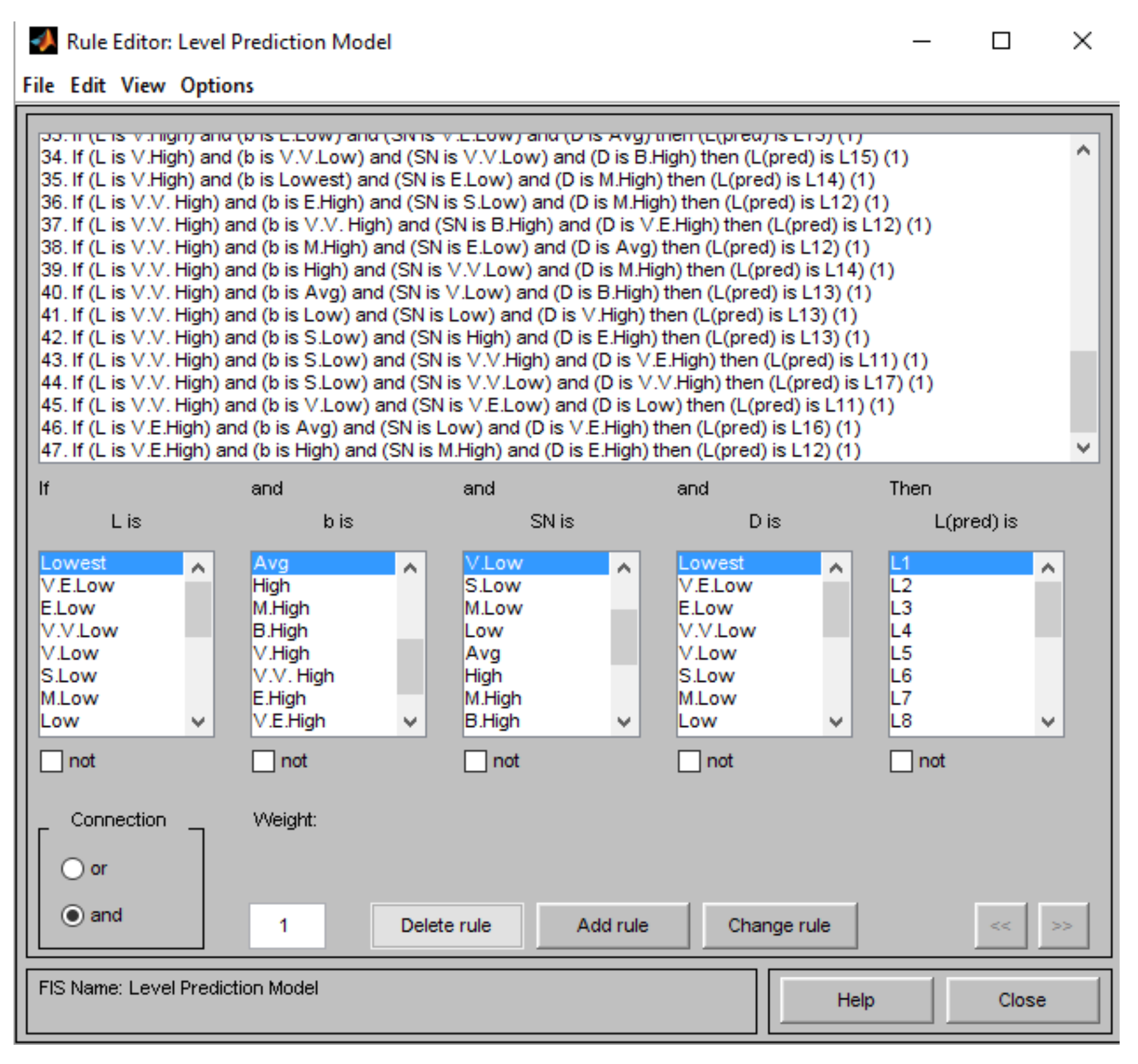
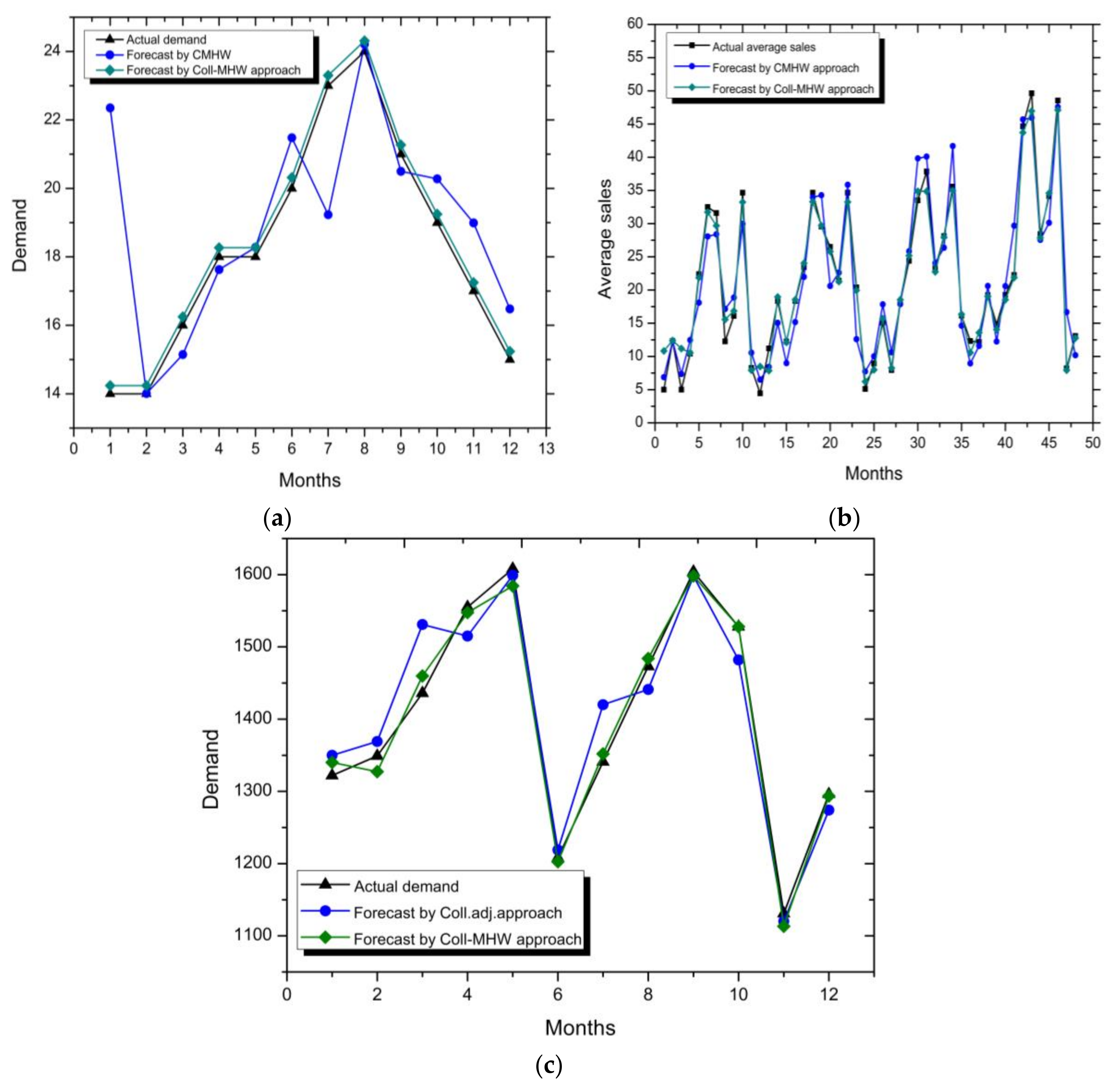

| Year | Parameter | Months | |||||||||||
|---|---|---|---|---|---|---|---|---|---|---|---|---|---|
| January | February | March | April | May | June | July | August | September | October | November | December | ||
| Year 1 | DT | 13 | 13 | 13 | 15 | 15 | 19 | 19 | 21 | 17 | 15 | 15 | 15 |
| bT | 0.27 | 0.27 | 0.27 | 0.27 | 0.27 | 0.27 | 0.27 | 0.27 | 0.27 | 0.27 | 0.27 | 0.27 | |
| LT | 14.54 | 14.78 | 13.88 | 14.76 | 14.76 | 15.90 | 16.80 | 17.87 | 17.16 | 15.88 | 16.10 | 16.86 | |
| SNT | 0.89 | 0.88 | 0.94 | 1.02 | 1.05 | 1.19 | 1.13 | 1.17 | 0.99 | 0.94 | 0.9316 | 0.89 | |
| YT | 12.18 | 13.03 | 14.09 | 14.38 | 15.28 | 17.95 | 18.29 | 20.06 | 17.99 | 16.47 | 15.04 | 14.57 | |
| ET(L) | 0.92 | −0.03 | −1.16 | 0.61 | −0.27 | 0.88 | 0.63 | 0.80 | −0.98 | −1.55 | −0.04 | 0.49 | |
| Year 2 | DT | 14 | 14 | 16 | 16 | 16 | 20 | 20 | 21 | 18 | 16 | 16 | 16 |
| bT | 0.27 | 0.27 | 0.27 | 0.27 | 0.27 | 0.27 | 0.27 | 0.27 | 0.27 | 0.27 | 0.27 | 0.27 | |
| LT | 15.66 | 15.91 | 17.089 | 15.75 | 15.74 | 16.74 | 17.69 | 17.87 | 18.17 | 16.94 | 17.18 | 17.98 | |
| SNT | 0.89 | 0.88 | 0.94 | 1.02 | 1.02 | 1.19 | 1.13 | 1.17 | 0.99 | 0.94 | 0.93 | 0.89 | |
| YT | 15.31 | 14.01 | 15.15 | 17.63 | 16.28 | 19.13 | 19.23 | 21.09 | 17.97 | 17.42 | 16.03 | 15.52 | |
| ET(L) | −1.47 | −0.01 | 0.90 | −1.61 | −0.27 | 0.73 | 0.68 | −0.08 | 0.03 | −1.50 | −0.03 | 0.54 | |
| Year 3 | DT | 18 | 18 | 20 | 23 | 24 | 26 | 23 | 23 | 21 | 24 | 24 | 22 |
| bT | 0.27 | 0.27 | 0.27 | 0.27 | 0.27 | 0.27 | 0.27 | 0.27 | 0.27 | 0.27 | 0.27 | 0.27 | |
| LT | 20.13 | 20.46 | 21.36 | 22.64 | 23.61 | 21.76 | 20.34 | 19.58 | 21.20 | 25.41 | 25.76 | 24.72 | |
| SNT | 0.89 | 0.88 | 0.94 | 1.01 | 1.05 | 1.19 | 1.13 | 1.17 | 0.99 | 0.94 | 0.93 | 0.89 | |
| YT | 16.32 | 17.95 | 19.41 | 21.97 | 23.28 | 28.53 | 24.91 | 24.21 | 19.66 | 20.28 | 23.92 | 23.16 | |
| ET(L) | 1.88 | 0.06 | 0.63 | 1.01 | 0.71 | −2.12 | −1.69 | −1.03 | 1.36 | 3.94 | 0.09 | −1.31 | |
| Variables | Linguistic Variables | Linguistic Values | Ranges |
|---|---|---|---|
| Input | Level (LT) | E. Low | 13~15 |
| V. Low | 14.75~17 | ||
| Low | 16.75~19 | ||
| Avg | 18.75~21 | ||
| High | 20.75~23 | ||
| V. High | 22.75~25 | ||
| E. High | 24.75~27 | ||
| Growth rate (bT) | E. Low | 0.1~0.2 | |
| V. Low | 0.175~0.3 | ||
| Low | 0.275~0.4 | ||
| Avg | 0.375~0.5 | ||
| High | 0.475~0.6 | ||
| V. High | 0.575~0.7 | ||
| E. High | 0.675~0.8 | ||
| Seasonal parameter (SNT) | E. Low | 0.8~0.84 | |
| V. Low | 0.837~0.88 | ||
| Low | 0.875~0.92 | ||
| Avg | 0.9175~0.96 | ||
| High | 0.9575~1 | ||
| V. High | 0.9975~1.4 | ||
| E. High | 1.375~1.8 | ||
| Demand (DT) | E. Low | 13~15 | |
| V. Low | 14.75~17 | ||
| Low | 16.75~19 | ||
| Avg | 18.75~21 | ||
| High | 20.75~23 | ||
| V. High | 22.75~25 | ||
| E. High | 24.75~27 | ||
| Output | Predicted level (LTpred) | L1 | 13~14 |
| L2 | 13.75~15 | ||
| L3 | 14.75~16 | ||
| L4 | 15.75~17 | ||
| L5 | 16.75~18 | ||
| L6 | 17.75~19 | ||
| L7 | 18.75~20 | ||
| L8 | 19.75~21 | ||
| L9 | 20.75~22 | ||
| L10 | 21.75~23 | ||
| L11 | 22.75~24 | ||
| L12 | 23.75~25 | ||
| L13 | 24.75~26 |
| Variable Name | Fuzzy Numbers | Variable Name | Fuzzy Numbers |
|---|---|---|---|
| Level, LT | E. Low = (13, 14, 15; 1) V. Low = (14.75, 16, 17; 1) Low= (16.75, 18, 19; 1) Avg= (18.75, 20, 21; 1) High= (20.75, 22, 23; 1) V. High = (22.75, 24, 25; 1) E. High = (24.75, 26, 27; 1) | Seasonal parameter (SNT) | E. Low = (0.8, 0.82, 0.84; 1) V. Low = (0.837, 0.86, 0.88; 1) Low = (0.875,0.9, 0.92; 1) Avg = (0.9175, 0.94, 0.96; 1) High = (0.9575, 0.98,1; 1) V. High = (0.9975, 1.2, 1.4; 1) E. High = (1.375, 1.6, 1.8; 1) |
| Growth Rate, bT | E. Low = (0.1, 0.15, 0.2; 1) V. Low = (0.175, 0.25, 0.3; 1) Low = (0.275, 0.35, 0.4; 1) Avg = (0.375, 0.45, 0.5; 1) High = (0.475, 0.55, 0.6; 1) V. High = (0.575, 0.65, 0.7; 1) E. High = (0.675, 0.75, 0.8; 1) | Predicted Level (LTpred) | L1 = (13, 13.5, 14; 1) L2 = (13.75, 14.5, 15; 1) L3 = (14.75, 15.5, 16; 1) L4 = (15.75, 16.5, 17; 1) L5 = (16.75, 17.5, 18; 1) L6 = (17.75, 18.5, 19; 1) L7 = (18.75, 19.5, 20; 1) L8 = (19.75, 20.5, 21; 1) L9 = (20.75, 21.5, 22; 1) L10 = (21.75, 22.5, 23; 1) L11 = (22.75, 23.5, 24; 1) L12 = (23.75, 24.5, 25; 1) L13 = (24.75, 25.5, 26; 1) |
| Actual Demand, DT | E. Low = (13, 14, 15; 1) V. Low = (14.75, 16, 17; 1) Low = (16.75, 18, 19; 1) Avg = (18.75, 20, 21; 1) High = (20.75, 22, 23; 1) V. High = (22.75, 24, 25; 1) E. High = (24.75, 26, 27; 1) |
| Variable | Linguistic Variables | Type | Coefficient | ||
|---|---|---|---|---|---|
| C1 | C2 | C3 | |||
| LT | E. Low | Triangular | 13 | 14 | 15 |
| V. Low | Triangular | 14.75 | 16 | 17 | |
| Low | Triangular | 16.75 | 18 | 19 | |
| Avg | Triangular | 18.75 | 20 | 21 | |
| High | Triangular | 20.75 | 22 | 23 | |
| V. High | Triangular | 22.75 | 24 | 25 | |
| E. High | Triangular | 24.75 | 26 | 27 | |
| bT | E. Low | Triangular | 0.1 | 0.15 | 0.2 |
| V. Low | Triangular | 0.175 | 0.25 | 0.3 | |
| Low | Triangular | 0.275 | 0.35 | 0.4 | |
| Avg | Triangular | 0.375 | 0.45 | 0.5 | |
| High | Triangular | 0.475 | 0.55 | 0.6 | |
| V. High | Triangular | 0.575 | 0.65 | 0.7 | |
| E. High | Triangular | 0.675 | 0.75 | 0.8 | |
| SNT | E. Low | Triangular | 0.8 | 0.82 | 0.84 |
| V. Low | Triangular | 0.837 | 0.86 | 0.88 | |
| Low | Triangular | 0.875 | 0.9 | 0.92 | |
| Avg | Triangular | 0.9175 | 0.94 | 0.96 | |
| High | Triangular | 0.9575 | 0.98 | 1 | |
| V. High | Triangular | 0.9975 | 1.2 | 1.4 | |
| E. High | Triangular | 1.375 | 1.6 | 1.8 | |
| DT | E. Low | Triangular | 13 | 14 | 15 |
| V. Low | Triangular | 14.75 | 16 | 17 | |
| Low | Triangular | 16.75 | 18 | 19 | |
| Avg | Triangular | 18.75 | 20 | 21 | |
| High | Triangular | 20.75 | 22 | 23 | |
| V. High | Triangular | 22.75 | 24 | 25 | |
| E. High | Triangular | 24.75 | 26 | 27 | |
| LTpred | L1 | Triangular | 13 | 13.5 | 14 |
| L2 | Triangular | 13.75 | 14.5 | 15 | |
| L3 | Triangular | 14.75 | 15.5 | 16 | |
| L4 | Triangular | 15.75 | 16.5 | 17 | |
| L5 | Triangular | 16.75 | 17.5 | 18 | |
| L6 | Triangular | 17.75 | 18.5 | 19 | |
| L7 | Triangular | 18.75 | 19.5 | 20 | |
| L8 | Triangular | 19.75 | 20.5 | 21 | |
| L9 | Triangular | 20.75 | 21.5 | 22 | |
| L10 | Triangular | 21.75 | 22.5 | 23 | |
| L11 | Triangular | 22.75 | 23.5 | 24 | |
| L12 | Triangular | 23.75 | 24.5 | 25 | |
| L13 | Triangular | 24.75 | 25.5 | 26 | |
| Components | Time Period | |||||||||||
|---|---|---|---|---|---|---|---|---|---|---|---|---|
| 1 | 2 | 3 | 4 | 5 | 6 | 7 | 8 | 9 | 10 | 11 | 12 | |
| DT | 14 | 14 | 16 | 18 | 18 | 20 | 23 | 24 | 21 | 19 | 17 | 15 |
| LT | 15.66 | 15.91 | 17.08 | 17.71 | 17.71 | 16.74 | 20.34 | 20.43 | 21.20 | 20.11 | 18.25 | 16.86 |
| LTpred | 15.4 | 15.4 | 16.4 | 17.4 | 17.4 | 17.4 | 19.5 | 19.5 | 22.4 | 21.4 | 19.5 | 17.4 |
| YT | 22.35 | 14.01 | 15.15 | 17.63 | 18.28 | 21.48 | 19.23 | 24.21 | 20.50 | 20.28 | 18.99 | 16.48 |
| YTc | 14.24 | 14.24 | 16.25 | 18.27 | 18.27 | 20.32 | 23.30 | 24.31 | 21.27 | 19.25 | 17.25 | 15.24 |
| Cases | Method Used Earlier | Forecast Error Obtained by Earlier Method | Forecast Error Obtained by Proposed Coll. MHW | Error Reduction | |||
|---|---|---|---|---|---|---|---|
| MAD | MSE | MAD | MSE | MAD | MSE | ||
| 1 | CMHW | 1.71 | 0.65 | 0.27 | 0.01 | 84.21% | 98.5% |
| 2 | CMHW | 9555.75 | 51,199.94 | 4972.62 | 13,757.55 | 48% | 73% |
| IMHW | 12,269.11 | 52,261.69 | 59.5% | 73.6% | |||
| 3 | ARIMA | 112.2 | 16,821 | 12.35 | 216.92 | 89% | 98% |
| Coll. Adj. | 33.91 | 1836.08 | 63.5% | 88% | |||
| Cases | Method Used Earlier | R2 Using Earlier Method | R2 for Proposed Coll-MHW Approach | Improvement |
|---|---|---|---|---|
| 1 | CMHW | 0.3614 | 0.9999 | 63.85% |
| 2 | CMHW | 0.9101 | 0.9798 | 6.97% |
| 3 | Coll. Adj. | 0.9180 | 0.9903 | 7.23% |
© 2018 by the authors. Licensee MDPI, Basel, Switzerland. This article is an open access article distributed under the terms and conditions of the Creative Commons Attribution (CC BY) license (http://creativecommons.org/licenses/by/4.0/).
Share and Cite
Kays, H.M.E.; Karim, A.N.M.; Daud, M.R.C.; Varela, M.L.R.; Putnik, G.D.; Machado, J.M. A Collaborative Multiplicative Holt-Winters Forecasting Approach with Dynamic Fuzzy-Level Component. Appl. Sci. 2018, 8, 530. https://doi.org/10.3390/app8040530
Kays HME, Karim ANM, Daud MRC, Varela MLR, Putnik GD, Machado JM. A Collaborative Multiplicative Holt-Winters Forecasting Approach with Dynamic Fuzzy-Level Component. Applied Sciences. 2018; 8(4):530. https://doi.org/10.3390/app8040530
Chicago/Turabian StyleKays, H. M. Emrul, A. N. M. Karim, Mohd Radzi C. Daud, Maria L. R. Varela, Goran D. Putnik, and José M. Machado. 2018. "A Collaborative Multiplicative Holt-Winters Forecasting Approach with Dynamic Fuzzy-Level Component" Applied Sciences 8, no. 4: 530. https://doi.org/10.3390/app8040530








